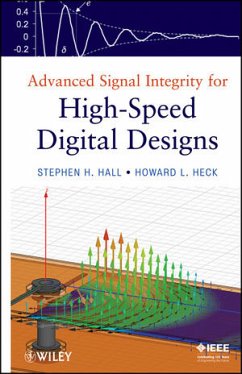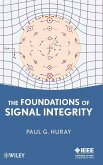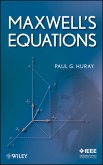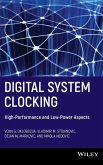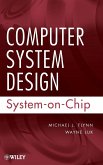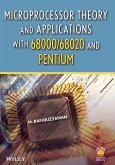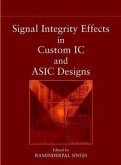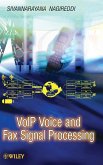- Gebundenes Buch
- Merkliste
- Auf die Merkliste
- Bewerten Bewerten
- Teilen
- Produkt teilen
- Produkterinnerung
- Produkterinnerung
Signal integrity has become the key issue in most high-performance digital designs. Now, from the foremost experts in the field, this book leverages theory and techniques from non-related fields such as applied physics, communications, and microwave engineering and applies them to the field of high-speed digital design. This approach creates an optimal combination of theory and practice that is meaningful to practicing engineers and graduate students alike.
A synergistic approach to signal integrity for high-speed digital design This book is designed to provide contemporary readers with an…mehr
Andere Kunden interessierten sich auch für
![The Foundations of Signal Integrity The Foundations of Signal Integrity]() Paul G HurayThe Foundations of Signal Integrity191,99 €
Paul G HurayThe Foundations of Signal Integrity191,99 €![Maxwell's Equations Maxwell's Equations]() Paul G HurayMaxwell's Equations171,99 €
Paul G HurayMaxwell's Equations171,99 €![Digital System Clocking Digital System Clocking]() Digital System Clocking186,99 €
Digital System Clocking186,99 €![Computer System Design Computer System Design]() Michael J. FlynnComputer System Design102,99 €
Michael J. FlynnComputer System Design102,99 €![Microprocessor Theory and Applications with 68000/68020 and Pentium Microprocessor Theory and Applications with 68000/68020 and Pentium]() Mohamed RafiquzzamanMicroprocessor Theory and Applications with 68000/68020 and Pentium213,99 €
Mohamed RafiquzzamanMicroprocessor Theory and Applications with 68000/68020 and Pentium213,99 €![Signal Integrity Effects in Custom IC and ASIC Designs Signal Integrity Effects in Custom IC and ASIC Designs]() Raminderpal Singh (Hrsg.)Signal Integrity Effects in Custom IC and ASIC Designs231,99 €
Raminderpal Singh (Hrsg.)Signal Integrity Effects in Custom IC and ASIC Designs231,99 €![VoIP Voice and Fax VoIP Voice and Fax]() Sivannarayana NagireddiVoIP Voice and Fax187,99 €
Sivannarayana NagireddiVoIP Voice and Fax187,99 €-
-
-
Signal integrity has become the key issue in most high-performance digital designs. Now, from the foremost experts in the field, this book leverages theory and techniques from non-related fields such as applied physics, communications, and microwave engineering and applies them to the field of high-speed digital design. This approach creates an optimal combination of theory and practice that is meaningful to practicing engineers and graduate students alike.
A synergistic approach to signal integrity for high-speed digital design This book is designed to provide contemporary readers with an understanding of the emerging high-speed signal integrity issues that are creating roadblocks in digital design. Written by the foremost experts on the subject, it leverages concepts and techniques from non-related fields such as applied physics and microwave engineering and applies them to high-speed digital design--creating the optimal combination between theory and practical applications. Following an introduction to the importance of signal integrity, chapter coverage includes: * Electromagnetic fundamentals for signal integrity * Transmission line fundamentals * Crosstalk * Non-ideal conductor models, including surface roughness and frequency-dependent inductance * Frequency-dependent properties of dielectrics * Differential signaling * Mathematical requirements of physical channels * S-parameters for digital engineers * Non-ideal return paths and via resonance * I/O circuits and models * Equalization * Modeling and budgeting of timing jitter and noise * System analysis using response surface modeling Each chapter includes many figures and numerous examples to help readers relate the concepts to everyday design and concludes with problems for readers to test their understanding of the material. Advanced Signal Integrity for High-Speed Digital Designs is suitable as a textbook for graduate-level courses on signal integrity, for programs taught in industry for professional engineers, and as a reference for the high-speed digital designer.
Hinweis: Dieser Artikel kann nur an eine deutsche Lieferadresse ausgeliefert werden.
A synergistic approach to signal integrity for high-speed digital design This book is designed to provide contemporary readers with an understanding of the emerging high-speed signal integrity issues that are creating roadblocks in digital design. Written by the foremost experts on the subject, it leverages concepts and techniques from non-related fields such as applied physics and microwave engineering and applies them to high-speed digital design--creating the optimal combination between theory and practical applications. Following an introduction to the importance of signal integrity, chapter coverage includes: * Electromagnetic fundamentals for signal integrity * Transmission line fundamentals * Crosstalk * Non-ideal conductor models, including surface roughness and frequency-dependent inductance * Frequency-dependent properties of dielectrics * Differential signaling * Mathematical requirements of physical channels * S-parameters for digital engineers * Non-ideal return paths and via resonance * I/O circuits and models * Equalization * Modeling and budgeting of timing jitter and noise * System analysis using response surface modeling Each chapter includes many figures and numerous examples to help readers relate the concepts to everyday design and concludes with problems for readers to test their understanding of the material. Advanced Signal Integrity for High-Speed Digital Designs is suitable as a textbook for graduate-level courses on signal integrity, for programs taught in industry for professional engineers, and as a reference for the high-speed digital designer.
Hinweis: Dieser Artikel kann nur an eine deutsche Lieferadresse ausgeliefert werden.
Produktdetails
- Produktdetails
- Verlag: John Wiley & Sons / Wiley
- Seitenzahl: 688
- Erscheinungstermin: 16. März 2009
- Englisch
- Abmessung: 240mm x 163mm x 38mm
- Gewicht: 1046g
- ISBN-13: 9780470192351
- ISBN-10: 0470192356
- Artikelnr.: 25933890
- Herstellerkennzeichnung
- Libri GmbH
- Europaallee 1
- 36244 Bad Hersfeld
- 06621 890
- Verlag: John Wiley & Sons / Wiley
- Seitenzahl: 688
- Erscheinungstermin: 16. März 2009
- Englisch
- Abmessung: 240mm x 163mm x 38mm
- Gewicht: 1046g
- ISBN-13: 9780470192351
- ISBN-10: 0470192356
- Artikelnr.: 25933890
- Herstellerkennzeichnung
- Libri GmbH
- Europaallee 1
- 36244 Bad Hersfeld
- 06621 890
STEPHEN H. HALL is a Senior Staff Engineer at Intel Corporation, where he leads a team focused on the research of new modeling and measurement solutions for channel speeds as high as 30Gb/sec. Previously at Intel, he was the lead designer for desktop and server buses on Pentium II, III, and IV based systems, coordinated research in the area of high-speed signaling with multiple universities, led research and development teams in the area of high-speed modeling, and taught signal integrity courses to engineers in two countries. He is also the author of High-Speed Digital System Design (Wiley). HOWARD L. HECK is a Principal Engineer at Intel Corporation, where he leads development of the signaling specifications and solutions for USB 3.0. He also teaches high-speed digital interconnect design at the Oregon Graduate Institute, is a Senior Member of the IEEE, and holds five patents in the area of high-performance packaging and interconnects, with five more pending.
Preface xv 1. Introduction: The Importance of Signal Integrity 1 1.1 Computing Power: Past and Future 1 1.2 The Problem 4 1.3 The Basics 5 1.4 A New Realm of Bus Design 7 1.5 Scope of the Book 7 1.6 Summary 8 References 8 2. Electromagnetic Fundamentals for Signal Integrity 9 2.1 Maxwell's Equations 10 2.2 Common Vector Operators 13 2.2.1 Vector 13 2.2.2 Dot Product 13 2.2.3 Cross Product 14 2.2.4 Vector and Scalar Fields 15 2.2.5 Flux 15 2.2.6 Gradient 18 2.2.7 Divergence 18 2.2.8 Curl 20 2.3 Wave Propagation 23 2.3.1 Wave Equation 23 2.3.2 Relation Between E and H and the Transverse Electromagnetic Mode 25 2.3.3 Time-Harmonic Fields 27 2.3.4 Propagation of Time-Harmonic Plane Waves 28 2.4 Electrostatics 32 2.4.1 Electrostatic Scalar Potential in Terms of an Electric Field 36 2.4.2 Energy in an Electric Field 37 2.4.3 Capacitance 40 2.4.4 Energy Stored in a Capacitor 41 2.5 Magnetostatics 42 2.5.1 Magnetic Vector Potential 46 2.5.2 Inductance 48 2.5.3 Energy in a Magnetic Field 51 2.6 Power Flow and the Poynting Vector 53 2.6.1 Time-Averaged Values 56 2.7 Reflections of Electromagnetic Waves 57 2.7.1 Plane Wave Incident on a Perfect Conductor 57 2.7.2 Plane Wave Incident on a Lossless Dielectric 60 References 62 Problems 62 3. Ideal Transmission-Line Fundamentals 65 3.1 Transmission-Line Structures 66 3.2 Wave Propagation on Loss-Free Transmission Lines 67 3.2.1 Electric and Magnetic Fields on a Transmission Line 68 3.2.2 Telegrapher's Equations 73 3.2.3 Equivalent Circuit for the Loss-Free Case 76 3.2.4 Wave Equation in Terms of LC 80 3.3 Transmission-Line Properties 82 3.3.1 Transmission-Line Phase Velocity 82 3.3.2 Transmission-Line Characteristic Impedance 82 3.3.3 Effective Dielectric Permittivity 83 3.3.4 Simple Formulas for Calculating the Characteristic Impedance 85 3.3.5 Validity of the TEM Approximation 86 3.4 Transmission-Line Parameters for the Loss-Free Case 90 3.4.1 Laplace and Poisson Equations 91 3.4.2 Transmission-Line Parameters for a Coaxial Line 91 3.4.3 Transmission-Line Parameters for a Microstrip 94 3.4.4 Charge Distribution Near a Conductor Edge 100 3.4.5 Charge Distribution and Transmission-Line Parameters 104 3.4.6 Field Mapping 107 3.5 Transmission-Line Reflections 113 3.5.1 Transmission-Line Reflection and Transmission Coefficient 113 3.5.2 Launching an Initial Wave 116 3.5.3 Multiple Reflections 116 3.5.4 Lattice Diagrams and Over- or Underdriven Transmission Lines 118 3.5.5 Lattice Diagrams for Nonideal Topologies 121 3.5.6 Effect of Rise and Fall Times on Reflections 129 3.5.7 Reflections from Reactive Loads 129 3.6 Time-Domain Reflectometry 134 3.6.1 Measuring the Characteristic Impedance and Delay of a Transmission Line 134 3.6.2 Measuring Inductance and Capacitance of Reactive Structures 137 3.6.3 Understanding the TDR Profile 140 References 140 Problems 141 4. Crosstalk 145 4.1 Mutual Inductance and Capacitance 146 4.1.1 Mutual Inductance 147 4.1.2 Mutual Capacitance 149 4.1.3 Field Solvers 152 4.2 Coupled Wave Equations 153 4.2.1 Wave Equation Revisited 153 4.2.2 Coupled Wave Equations 155 4.3 Coupled Line Analysis 157 4.3.1 Impedance and Velocity 157 4.3.2 Coupled Noise 165 4.4 Modal Analysis 177 4.4.1 Modal Decomposition 178 4.4.2 Modal Impedance and Velocity 180 4.4.3 Reconstructing the Signal 180 4.4.4 Modal Analysis 181 4.4.5 Modal Analysis of Lossy Lines 192 4.5 Crosstalk Minimization 193 4.6 Summary 194 References 195 Problems 195 5. Nonideal Conductor Models 201 5.1 Signals Propagating in Unbounded Conductive Media 202 5.1.1 Propagation Constant for Conductive Media 202 5.1.2 Skin Depth 204 5.2 Classic Conductor Model for Transmission Lines 205 5.2.1 Dc Losses in Conductors 206 5.2.2 Frequency-Dependent Resistance in Conductors 207 5.2.3 Frequency-Dependent Inductance 213 5.2.4 Power Loss in a Smooth Conductor 218 5.3 Surface Roughness 222 5.3.1 Hammerstad Model 223 5.3.2 Hemispherical Model 228 5.3.3 Huray Model 237 5.3.4 Conclusions 243 5.4 Transmission-Line Parameters for Nonideal Conductors 244 5.4.1 Equivalent Circuit Impedance and Propagation Constant 244 5.4.2 Telegrapher's Equations for a Real Conductor and a Perfect Dielectric 246 References 247 Problems 247 6. Electrical Properties of Dielectrics 249 6.1 Polarization of Dielectrics 250 6.1.1 Electronic Polarization 250 6.1.2 Orientational (Dipole) Polarization 253 6.1.3 Ionic (Molecular) Polarization 253 6.1.4 Relative Permittivity 254 6.2 Classification of Dielectric Materials 256 6.3 Frequency-Dependent Dielectric Behavior 256 6.3.1 Dc Dielectric Losses 257 6.3.2 Frequency-Dependent Dielectric Model: Single Pole 257 6.3.3 Anomalous Dispersion 261 6.3.4 Frequency-Dependent Dielectric Model: Multipole 262 6.3.5 Infinite-Pole Model 266 6.4 Properties of a Physical Dielectric Model 269 6.4.1 Relationship Between
_ and
__ 269 6.4.2 Mathematical Limits 271 6.5 Fiber-Weave Effect 274 6.5.1 Physical Structure of an FR4 Dielectric and Dielectric Constant Variation 275 6.5.2 Mitigation 276 6.5.3 Modeling the Fiber-Weave Effect 277 6.6 Environmental Variation in Dielectric Behavior 279 6.6.1 Environmental Effects on Transmission-Line Performance 281 6.6.2 Mitigation 283 6.6.3 Modeling the Effect of Relative Humidity on an FR4 Dielectric 284 6.7 Transmission-Line Parameters for Lossy Dielectrics and Realistic Conductors 285 6.7.1 Equivalent Circuit Impedance and Propagation Constant 285 6.7.2 Telegrapher's Equations for Realistic Conductors and Lossy Dielectrics 291 References 292 Problems 292 7. Differential Signaling 297 7.1 Removal of Common-Mode Noise 299 7.2 Differential Crosstalk 300 7.3 Virtual Reference Plane 302 7.4 Propagation of Modal Voltages 303 7.5 Common Terminology 304 7.6 Drawbacks of Differential Signaling 305 7.6.1 Mode Conversion 305 7.6.2 Fiber-Weave Effect 310 Reference 313 Problems 313 8. Mathematical Requirements for Physical Channels 315 8.1 Frequency-Domain Effects in Time-Domain Simulations 316 8.1.1 Linear and Time Invariance 316 8.1.2 Time- and Frequency-Domain Equivalencies 317 8.1.3 Frequency Spectrum of a Digital Pulse 321 8.1.4 System Response 324 8.1.5 Single-Bit (Pulse) Response 327 8.2 Requirements for a Physical Channel 331 8.2.1 Causality 331 8.2.2 Passivity 340 8.2.3 Stability 343 References 345 Problems 345 9. Network Analysis for Digital Engineers 347 9.1 High-Frequency Voltage and Current Waves 349 9.1.1 Input Reflection into a Terminated Network 349 9.1.2 Input Impedance 353 9.2 Network Theory 354 9.2.1 Impedance Matrix 355 9.2.2 Scattering Matrix 358 9.2.3 ABCD Parameters 382 9.2.4 Cascading S-Parameters 390 9.2.5 Calibration and Deembedding 395 9.2.6 Changing the Reference Impedance 399 9.2.7 Multimode S-Parameters 400 9.3 Properties of Physical S-Parameters 406 9.3.1 Passivity 406 9.3.2 Reality 408 9.3.3 Causality 408 9.3.4 Subjective Examination of S-Parameters 410 References 413 Problems 413 10. Topics in High-Speed Channel Modeling 417 10.1 Creating a Physical Transmission-Line Model 418 10.1.1 Tabular Approach 418 10.1.2 Generating a Tabular Dielectric Model 419 10.1.3 Generating a Tabular Conductor Model 420 10.2 NonIdeal Return Paths 422 10.2.1 Path of Least Impedance 422 10.2.2 Transmission Line Routed Over a Gap in the Reference Plane 423 10.2.3 Summary 434 10.3 Vias 434 10.3.1 Via Resonance 434 10.3.2 Plane Radiation Losses 437 10.3.3 Parallel-Plate Waveguide 439 References 441 Problems 442 11. I/O Circuits and Models 443 11.1 I/O Design Considerations 444 11.2 Push-Pull Transmitters 446 11.2.1 Operation 446 11.2.2 Linear Models 448 11.2.3 Nonlinear Models 453 11.2.4 Advanced Design Considerations 455 11.3 CMOS receivers 459 11.3.1 Operation 459 11.3.2 Modeling 460 11.3.3 Advanced Design Considerations 460 11.4 ESD Protection Circuits 460 11.4.1 Operation 461 11.4.2 Modeling 461 11.4.3 Advanced Design Considerations 463 11.5 On-Chip Termination 463 11.5.1 Operation 463 11.5.2 Modeling 463 11.5.3 Advanced Design Considerations 464 11.6 Bergeron Diagrams 465 11.6.1 Theory and Method 470 11.6.2 Limitations 474 11.7 Open-Drain Transmitters 474 11.7.1 Operation 474 11.7.2 Modeling 476 11.7.3 Advanced Design Considerations 476 11.8 Differential Current-Mode Transmitters 479 11.8.1 Operation 479 11.8.2 Modeling 480 11.8.3 Advanced Design Considerations 480 11.9 Low-Swing and Differential Receivers 481 11.9.1 Operation 481 11.9.2 Modeling 482 11.9.3 Advanced Design Considerations 483 11.10 IBIS Models 483 11.10.1 Model Structure and Development Process 483 11.10.2 Generating Model Data 485 11.10.3 Differential I/O Models 488 11.10.4 Example of an IBIS File 490 11.11 Summary 492 References 492 Problems 494 12. Equalization 499 12.1 Analysis and Design Background 500 12.1.1 Maximum Data Transfer Capacity 500 12.1.2 Linear Time-Invariant Systems 502 12.1.3 Ideal Versus Practical Interconnects 506 12.1.4 Equalization Overview 511 12.2 Continuous-Time Linear Equalizers 513 12.2.1 Passive CTLEs 514 12.2.2 Active CTLEs 521 12.3 Discrete Linear Equalizers 522 12.3.1 Transmitter Equalization 525 12.3.2 Coefficient Selection 530 12.3.3 Receiver Equalization 535 12.3.4 Nonidealities in DLEs 536 12.3.5 Adaptive Equalization 536 12.4 Decision Feedback Equalization 540 12.5 Summary 542 References 545 Problems 546 13. Modeling and Budgeting of Timing Jitter and Noise 549 13.1 Eye Diagram 550 13.2 Bit Error Rate 552 13.2.1 Worst-Case Analysis 552 13.2.2 Bit Error Rate Analysis 555 13.3 Jitter Sources and Budgets 560 13.3.1 Jitter Types and Sources 561 13.3.2 System Jitter Budgets 568 13.4 Noise Sources and Budgets 572 13.4.1 Noise Sources 572 13.4.2 Noise Budgets 579 13.5 Peak Distortion Analysis Methods 583 13.5.1 Superposition and the Pulse Response 583 13.5.2 Worst-Case Bit Patterns and Data Eyes 585 13.5.3 Peak Distortion Analysis Including Crosstalk 594 13.5.4 Limitations 598 13.6 Summary 599 References 599 Problems 600 14. System Analysis Using Response Surface Modeling 605 14.1 Model Design Considerations 606 14.2 Case Study: 10-Gb/s Differential PCB Interface 607 14.3 RSM Construction by Least Squares Fitting 607 14.4 Measures of Fit 615 14.4.1 Residuals 615 14.4.2 Fit Coefficients 616 14.5 Significance Testing 618 14.5.1 Model Significance: The F-Test 618 14.5.2 Parameter Significance: Individual t-Tests 619 14.6 Confidence Intervals 621 14.7 Sensitivity Analysis and Design Optimization 623 14.8 Defect Rate Prediction Using Monte Carlo Simulation 628 14.9 Additional RSM Considerations 633 14.10 Summary 633 References 634 Problems 635 Appendix A: Useful Formulas Identities Units and Constants 637 Appendix B: Four-Port Conversions Between T- and S-Parameters 641 Appendix C: Critical Values of the F-Statistic 645 Appendix D: Critical Values of the T-Statistic 647 Appendix E: Causal Relationship Between Skin Effect Resistance and Internal Inductance for Rough Conductors 649 Appendix F: Spice Level 3 Model for 0.25
m MOSIS Process 653 Index 655
_ and
__ 269 6.4.2 Mathematical Limits 271 6.5 Fiber-Weave Effect 274 6.5.1 Physical Structure of an FR4 Dielectric and Dielectric Constant Variation 275 6.5.2 Mitigation 276 6.5.3 Modeling the Fiber-Weave Effect 277 6.6 Environmental Variation in Dielectric Behavior 279 6.6.1 Environmental Effects on Transmission-Line Performance 281 6.6.2 Mitigation 283 6.6.3 Modeling the Effect of Relative Humidity on an FR4 Dielectric 284 6.7 Transmission-Line Parameters for Lossy Dielectrics and Realistic Conductors 285 6.7.1 Equivalent Circuit Impedance and Propagation Constant 285 6.7.2 Telegrapher's Equations for Realistic Conductors and Lossy Dielectrics 291 References 292 Problems 292 7. Differential Signaling 297 7.1 Removal of Common-Mode Noise 299 7.2 Differential Crosstalk 300 7.3 Virtual Reference Plane 302 7.4 Propagation of Modal Voltages 303 7.5 Common Terminology 304 7.6 Drawbacks of Differential Signaling 305 7.6.1 Mode Conversion 305 7.6.2 Fiber-Weave Effect 310 Reference 313 Problems 313 8. Mathematical Requirements for Physical Channels 315 8.1 Frequency-Domain Effects in Time-Domain Simulations 316 8.1.1 Linear and Time Invariance 316 8.1.2 Time- and Frequency-Domain Equivalencies 317 8.1.3 Frequency Spectrum of a Digital Pulse 321 8.1.4 System Response 324 8.1.5 Single-Bit (Pulse) Response 327 8.2 Requirements for a Physical Channel 331 8.2.1 Causality 331 8.2.2 Passivity 340 8.2.3 Stability 343 References 345 Problems 345 9. Network Analysis for Digital Engineers 347 9.1 High-Frequency Voltage and Current Waves 349 9.1.1 Input Reflection into a Terminated Network 349 9.1.2 Input Impedance 353 9.2 Network Theory 354 9.2.1 Impedance Matrix 355 9.2.2 Scattering Matrix 358 9.2.3 ABCD Parameters 382 9.2.4 Cascading S-Parameters 390 9.2.5 Calibration and Deembedding 395 9.2.6 Changing the Reference Impedance 399 9.2.7 Multimode S-Parameters 400 9.3 Properties of Physical S-Parameters 406 9.3.1 Passivity 406 9.3.2 Reality 408 9.3.3 Causality 408 9.3.4 Subjective Examination of S-Parameters 410 References 413 Problems 413 10. Topics in High-Speed Channel Modeling 417 10.1 Creating a Physical Transmission-Line Model 418 10.1.1 Tabular Approach 418 10.1.2 Generating a Tabular Dielectric Model 419 10.1.3 Generating a Tabular Conductor Model 420 10.2 NonIdeal Return Paths 422 10.2.1 Path of Least Impedance 422 10.2.2 Transmission Line Routed Over a Gap in the Reference Plane 423 10.2.3 Summary 434 10.3 Vias 434 10.3.1 Via Resonance 434 10.3.2 Plane Radiation Losses 437 10.3.3 Parallel-Plate Waveguide 439 References 441 Problems 442 11. I/O Circuits and Models 443 11.1 I/O Design Considerations 444 11.2 Push-Pull Transmitters 446 11.2.1 Operation 446 11.2.2 Linear Models 448 11.2.3 Nonlinear Models 453 11.2.4 Advanced Design Considerations 455 11.3 CMOS receivers 459 11.3.1 Operation 459 11.3.2 Modeling 460 11.3.3 Advanced Design Considerations 460 11.4 ESD Protection Circuits 460 11.4.1 Operation 461 11.4.2 Modeling 461 11.4.3 Advanced Design Considerations 463 11.5 On-Chip Termination 463 11.5.1 Operation 463 11.5.2 Modeling 463 11.5.3 Advanced Design Considerations 464 11.6 Bergeron Diagrams 465 11.6.1 Theory and Method 470 11.6.2 Limitations 474 11.7 Open-Drain Transmitters 474 11.7.1 Operation 474 11.7.2 Modeling 476 11.7.3 Advanced Design Considerations 476 11.8 Differential Current-Mode Transmitters 479 11.8.1 Operation 479 11.8.2 Modeling 480 11.8.3 Advanced Design Considerations 480 11.9 Low-Swing and Differential Receivers 481 11.9.1 Operation 481 11.9.2 Modeling 482 11.9.3 Advanced Design Considerations 483 11.10 IBIS Models 483 11.10.1 Model Structure and Development Process 483 11.10.2 Generating Model Data 485 11.10.3 Differential I/O Models 488 11.10.4 Example of an IBIS File 490 11.11 Summary 492 References 492 Problems 494 12. Equalization 499 12.1 Analysis and Design Background 500 12.1.1 Maximum Data Transfer Capacity 500 12.1.2 Linear Time-Invariant Systems 502 12.1.3 Ideal Versus Practical Interconnects 506 12.1.4 Equalization Overview 511 12.2 Continuous-Time Linear Equalizers 513 12.2.1 Passive CTLEs 514 12.2.2 Active CTLEs 521 12.3 Discrete Linear Equalizers 522 12.3.1 Transmitter Equalization 525 12.3.2 Coefficient Selection 530 12.3.3 Receiver Equalization 535 12.3.4 Nonidealities in DLEs 536 12.3.5 Adaptive Equalization 536 12.4 Decision Feedback Equalization 540 12.5 Summary 542 References 545 Problems 546 13. Modeling and Budgeting of Timing Jitter and Noise 549 13.1 Eye Diagram 550 13.2 Bit Error Rate 552 13.2.1 Worst-Case Analysis 552 13.2.2 Bit Error Rate Analysis 555 13.3 Jitter Sources and Budgets 560 13.3.1 Jitter Types and Sources 561 13.3.2 System Jitter Budgets 568 13.4 Noise Sources and Budgets 572 13.4.1 Noise Sources 572 13.4.2 Noise Budgets 579 13.5 Peak Distortion Analysis Methods 583 13.5.1 Superposition and the Pulse Response 583 13.5.2 Worst-Case Bit Patterns and Data Eyes 585 13.5.3 Peak Distortion Analysis Including Crosstalk 594 13.5.4 Limitations 598 13.6 Summary 599 References 599 Problems 600 14. System Analysis Using Response Surface Modeling 605 14.1 Model Design Considerations 606 14.2 Case Study: 10-Gb/s Differential PCB Interface 607 14.3 RSM Construction by Least Squares Fitting 607 14.4 Measures of Fit 615 14.4.1 Residuals 615 14.4.2 Fit Coefficients 616 14.5 Significance Testing 618 14.5.1 Model Significance: The F-Test 618 14.5.2 Parameter Significance: Individual t-Tests 619 14.6 Confidence Intervals 621 14.7 Sensitivity Analysis and Design Optimization 623 14.8 Defect Rate Prediction Using Monte Carlo Simulation 628 14.9 Additional RSM Considerations 633 14.10 Summary 633 References 634 Problems 635 Appendix A: Useful Formulas Identities Units and Constants 637 Appendix B: Four-Port Conversions Between T- and S-Parameters 641 Appendix C: Critical Values of the F-Statistic 645 Appendix D: Critical Values of the T-Statistic 647 Appendix E: Causal Relationship Between Skin Effect Resistance and Internal Inductance for Rough Conductors 649 Appendix F: Spice Level 3 Model for 0.25
m MOSIS Process 653 Index 655
Preface xv 1. Introduction: The Importance of Signal Integrity 1 1.1 Computing Power: Past and Future 1 1.2 The Problem 4 1.3 The Basics 5 1.4 A New Realm of Bus Design 7 1.5 Scope of the Book 7 1.6 Summary 8 References 8 2. Electromagnetic Fundamentals for Signal Integrity 9 2.1 Maxwell's Equations 10 2.2 Common Vector Operators 13 2.2.1 Vector 13 2.2.2 Dot Product 13 2.2.3 Cross Product 14 2.2.4 Vector and Scalar Fields 15 2.2.5 Flux 15 2.2.6 Gradient 18 2.2.7 Divergence 18 2.2.8 Curl 20 2.3 Wave Propagation 23 2.3.1 Wave Equation 23 2.3.2 Relation Between E and H and the Transverse Electromagnetic Mode 25 2.3.3 Time-Harmonic Fields 27 2.3.4 Propagation of Time-Harmonic Plane Waves 28 2.4 Electrostatics 32 2.4.1 Electrostatic Scalar Potential in Terms of an Electric Field 36 2.4.2 Energy in an Electric Field 37 2.4.3 Capacitance 40 2.4.4 Energy Stored in a Capacitor 41 2.5 Magnetostatics 42 2.5.1 Magnetic Vector Potential 46 2.5.2 Inductance 48 2.5.3 Energy in a Magnetic Field 51 2.6 Power Flow and the Poynting Vector 53 2.6.1 Time-Averaged Values 56 2.7 Reflections of Electromagnetic Waves 57 2.7.1 Plane Wave Incident on a Perfect Conductor 57 2.7.2 Plane Wave Incident on a Lossless Dielectric 60 References 62 Problems 62 3. Ideal Transmission-Line Fundamentals 65 3.1 Transmission-Line Structures 66 3.2 Wave Propagation on Loss-Free Transmission Lines 67 3.2.1 Electric and Magnetic Fields on a Transmission Line 68 3.2.2 Telegrapher's Equations 73 3.2.3 Equivalent Circuit for the Loss-Free Case 76 3.2.4 Wave Equation in Terms of LC 80 3.3 Transmission-Line Properties 82 3.3.1 Transmission-Line Phase Velocity 82 3.3.2 Transmission-Line Characteristic Impedance 82 3.3.3 Effective Dielectric Permittivity 83 3.3.4 Simple Formulas for Calculating the Characteristic Impedance 85 3.3.5 Validity of the TEM Approximation 86 3.4 Transmission-Line Parameters for the Loss-Free Case 90 3.4.1 Laplace and Poisson Equations 91 3.4.2 Transmission-Line Parameters for a Coaxial Line 91 3.4.3 Transmission-Line Parameters for a Microstrip 94 3.4.4 Charge Distribution Near a Conductor Edge 100 3.4.5 Charge Distribution and Transmission-Line Parameters 104 3.4.6 Field Mapping 107 3.5 Transmission-Line Reflections 113 3.5.1 Transmission-Line Reflection and Transmission Coefficient 113 3.5.2 Launching an Initial Wave 116 3.5.3 Multiple Reflections 116 3.5.4 Lattice Diagrams and Over- or Underdriven Transmission Lines 118 3.5.5 Lattice Diagrams for Nonideal Topologies 121 3.5.6 Effect of Rise and Fall Times on Reflections 129 3.5.7 Reflections from Reactive Loads 129 3.6 Time-Domain Reflectometry 134 3.6.1 Measuring the Characteristic Impedance and Delay of a Transmission Line 134 3.6.2 Measuring Inductance and Capacitance of Reactive Structures 137 3.6.3 Understanding the TDR Profile 140 References 140 Problems 141 4. Crosstalk 145 4.1 Mutual Inductance and Capacitance 146 4.1.1 Mutual Inductance 147 4.1.2 Mutual Capacitance 149 4.1.3 Field Solvers 152 4.2 Coupled Wave Equations 153 4.2.1 Wave Equation Revisited 153 4.2.2 Coupled Wave Equations 155 4.3 Coupled Line Analysis 157 4.3.1 Impedance and Velocity 157 4.3.2 Coupled Noise 165 4.4 Modal Analysis 177 4.4.1 Modal Decomposition 178 4.4.2 Modal Impedance and Velocity 180 4.4.3 Reconstructing the Signal 180 4.4.4 Modal Analysis 181 4.4.5 Modal Analysis of Lossy Lines 192 4.5 Crosstalk Minimization 193 4.6 Summary 194 References 195 Problems 195 5. Nonideal Conductor Models 201 5.1 Signals Propagating in Unbounded Conductive Media 202 5.1.1 Propagation Constant for Conductive Media 202 5.1.2 Skin Depth 204 5.2 Classic Conductor Model for Transmission Lines 205 5.2.1 Dc Losses in Conductors 206 5.2.2 Frequency-Dependent Resistance in Conductors 207 5.2.3 Frequency-Dependent Inductance 213 5.2.4 Power Loss in a Smooth Conductor 218 5.3 Surface Roughness 222 5.3.1 Hammerstad Model 223 5.3.2 Hemispherical Model 228 5.3.3 Huray Model 237 5.3.4 Conclusions 243 5.4 Transmission-Line Parameters for Nonideal Conductors 244 5.4.1 Equivalent Circuit Impedance and Propagation Constant 244 5.4.2 Telegrapher's Equations for a Real Conductor and a Perfect Dielectric 246 References 247 Problems 247 6. Electrical Properties of Dielectrics 249 6.1 Polarization of Dielectrics 250 6.1.1 Electronic Polarization 250 6.1.2 Orientational (Dipole) Polarization 253 6.1.3 Ionic (Molecular) Polarization 253 6.1.4 Relative Permittivity 254 6.2 Classification of Dielectric Materials 256 6.3 Frequency-Dependent Dielectric Behavior 256 6.3.1 Dc Dielectric Losses 257 6.3.2 Frequency-Dependent Dielectric Model: Single Pole 257 6.3.3 Anomalous Dispersion 261 6.3.4 Frequency-Dependent Dielectric Model: Multipole 262 6.3.5 Infinite-Pole Model 266 6.4 Properties of a Physical Dielectric Model 269 6.4.1 Relationship Between
_ and
__ 269 6.4.2 Mathematical Limits 271 6.5 Fiber-Weave Effect 274 6.5.1 Physical Structure of an FR4 Dielectric and Dielectric Constant Variation 275 6.5.2 Mitigation 276 6.5.3 Modeling the Fiber-Weave Effect 277 6.6 Environmental Variation in Dielectric Behavior 279 6.6.1 Environmental Effects on Transmission-Line Performance 281 6.6.2 Mitigation 283 6.6.3 Modeling the Effect of Relative Humidity on an FR4 Dielectric 284 6.7 Transmission-Line Parameters for Lossy Dielectrics and Realistic Conductors 285 6.7.1 Equivalent Circuit Impedance and Propagation Constant 285 6.7.2 Telegrapher's Equations for Realistic Conductors and Lossy Dielectrics 291 References 292 Problems 292 7. Differential Signaling 297 7.1 Removal of Common-Mode Noise 299 7.2 Differential Crosstalk 300 7.3 Virtual Reference Plane 302 7.4 Propagation of Modal Voltages 303 7.5 Common Terminology 304 7.6 Drawbacks of Differential Signaling 305 7.6.1 Mode Conversion 305 7.6.2 Fiber-Weave Effect 310 Reference 313 Problems 313 8. Mathematical Requirements for Physical Channels 315 8.1 Frequency-Domain Effects in Time-Domain Simulations 316 8.1.1 Linear and Time Invariance 316 8.1.2 Time- and Frequency-Domain Equivalencies 317 8.1.3 Frequency Spectrum of a Digital Pulse 321 8.1.4 System Response 324 8.1.5 Single-Bit (Pulse) Response 327 8.2 Requirements for a Physical Channel 331 8.2.1 Causality 331 8.2.2 Passivity 340 8.2.3 Stability 343 References 345 Problems 345 9. Network Analysis for Digital Engineers 347 9.1 High-Frequency Voltage and Current Waves 349 9.1.1 Input Reflection into a Terminated Network 349 9.1.2 Input Impedance 353 9.2 Network Theory 354 9.2.1 Impedance Matrix 355 9.2.2 Scattering Matrix 358 9.2.3 ABCD Parameters 382 9.2.4 Cascading S-Parameters 390 9.2.5 Calibration and Deembedding 395 9.2.6 Changing the Reference Impedance 399 9.2.7 Multimode S-Parameters 400 9.3 Properties of Physical S-Parameters 406 9.3.1 Passivity 406 9.3.2 Reality 408 9.3.3 Causality 408 9.3.4 Subjective Examination of S-Parameters 410 References 413 Problems 413 10. Topics in High-Speed Channel Modeling 417 10.1 Creating a Physical Transmission-Line Model 418 10.1.1 Tabular Approach 418 10.1.2 Generating a Tabular Dielectric Model 419 10.1.3 Generating a Tabular Conductor Model 420 10.2 NonIdeal Return Paths 422 10.2.1 Path of Least Impedance 422 10.2.2 Transmission Line Routed Over a Gap in the Reference Plane 423 10.2.3 Summary 434 10.3 Vias 434 10.3.1 Via Resonance 434 10.3.2 Plane Radiation Losses 437 10.3.3 Parallel-Plate Waveguide 439 References 441 Problems 442 11. I/O Circuits and Models 443 11.1 I/O Design Considerations 444 11.2 Push-Pull Transmitters 446 11.2.1 Operation 446 11.2.2 Linear Models 448 11.2.3 Nonlinear Models 453 11.2.4 Advanced Design Considerations 455 11.3 CMOS receivers 459 11.3.1 Operation 459 11.3.2 Modeling 460 11.3.3 Advanced Design Considerations 460 11.4 ESD Protection Circuits 460 11.4.1 Operation 461 11.4.2 Modeling 461 11.4.3 Advanced Design Considerations 463 11.5 On-Chip Termination 463 11.5.1 Operation 463 11.5.2 Modeling 463 11.5.3 Advanced Design Considerations 464 11.6 Bergeron Diagrams 465 11.6.1 Theory and Method 470 11.6.2 Limitations 474 11.7 Open-Drain Transmitters 474 11.7.1 Operation 474 11.7.2 Modeling 476 11.7.3 Advanced Design Considerations 476 11.8 Differential Current-Mode Transmitters 479 11.8.1 Operation 479 11.8.2 Modeling 480 11.8.3 Advanced Design Considerations 480 11.9 Low-Swing and Differential Receivers 481 11.9.1 Operation 481 11.9.2 Modeling 482 11.9.3 Advanced Design Considerations 483 11.10 IBIS Models 483 11.10.1 Model Structure and Development Process 483 11.10.2 Generating Model Data 485 11.10.3 Differential I/O Models 488 11.10.4 Example of an IBIS File 490 11.11 Summary 492 References 492 Problems 494 12. Equalization 499 12.1 Analysis and Design Background 500 12.1.1 Maximum Data Transfer Capacity 500 12.1.2 Linear Time-Invariant Systems 502 12.1.3 Ideal Versus Practical Interconnects 506 12.1.4 Equalization Overview 511 12.2 Continuous-Time Linear Equalizers 513 12.2.1 Passive CTLEs 514 12.2.2 Active CTLEs 521 12.3 Discrete Linear Equalizers 522 12.3.1 Transmitter Equalization 525 12.3.2 Coefficient Selection 530 12.3.3 Receiver Equalization 535 12.3.4 Nonidealities in DLEs 536 12.3.5 Adaptive Equalization 536 12.4 Decision Feedback Equalization 540 12.5 Summary 542 References 545 Problems 546 13. Modeling and Budgeting of Timing Jitter and Noise 549 13.1 Eye Diagram 550 13.2 Bit Error Rate 552 13.2.1 Worst-Case Analysis 552 13.2.2 Bit Error Rate Analysis 555 13.3 Jitter Sources and Budgets 560 13.3.1 Jitter Types and Sources 561 13.3.2 System Jitter Budgets 568 13.4 Noise Sources and Budgets 572 13.4.1 Noise Sources 572 13.4.2 Noise Budgets 579 13.5 Peak Distortion Analysis Methods 583 13.5.1 Superposition and the Pulse Response 583 13.5.2 Worst-Case Bit Patterns and Data Eyes 585 13.5.3 Peak Distortion Analysis Including Crosstalk 594 13.5.4 Limitations 598 13.6 Summary 599 References 599 Problems 600 14. System Analysis Using Response Surface Modeling 605 14.1 Model Design Considerations 606 14.2 Case Study: 10-Gb/s Differential PCB Interface 607 14.3 RSM Construction by Least Squares Fitting 607 14.4 Measures of Fit 615 14.4.1 Residuals 615 14.4.2 Fit Coefficients 616 14.5 Significance Testing 618 14.5.1 Model Significance: The F-Test 618 14.5.2 Parameter Significance: Individual t-Tests 619 14.6 Confidence Intervals 621 14.7 Sensitivity Analysis and Design Optimization 623 14.8 Defect Rate Prediction Using Monte Carlo Simulation 628 14.9 Additional RSM Considerations 633 14.10 Summary 633 References 634 Problems 635 Appendix A: Useful Formulas Identities Units and Constants 637 Appendix B: Four-Port Conversions Between T- and S-Parameters 641 Appendix C: Critical Values of the F-Statistic 645 Appendix D: Critical Values of the T-Statistic 647 Appendix E: Causal Relationship Between Skin Effect Resistance and Internal Inductance for Rough Conductors 649 Appendix F: Spice Level 3 Model for 0.25
m MOSIS Process 653 Index 655
_ and
__ 269 6.4.2 Mathematical Limits 271 6.5 Fiber-Weave Effect 274 6.5.1 Physical Structure of an FR4 Dielectric and Dielectric Constant Variation 275 6.5.2 Mitigation 276 6.5.3 Modeling the Fiber-Weave Effect 277 6.6 Environmental Variation in Dielectric Behavior 279 6.6.1 Environmental Effects on Transmission-Line Performance 281 6.6.2 Mitigation 283 6.6.3 Modeling the Effect of Relative Humidity on an FR4 Dielectric 284 6.7 Transmission-Line Parameters for Lossy Dielectrics and Realistic Conductors 285 6.7.1 Equivalent Circuit Impedance and Propagation Constant 285 6.7.2 Telegrapher's Equations for Realistic Conductors and Lossy Dielectrics 291 References 292 Problems 292 7. Differential Signaling 297 7.1 Removal of Common-Mode Noise 299 7.2 Differential Crosstalk 300 7.3 Virtual Reference Plane 302 7.4 Propagation of Modal Voltages 303 7.5 Common Terminology 304 7.6 Drawbacks of Differential Signaling 305 7.6.1 Mode Conversion 305 7.6.2 Fiber-Weave Effect 310 Reference 313 Problems 313 8. Mathematical Requirements for Physical Channels 315 8.1 Frequency-Domain Effects in Time-Domain Simulations 316 8.1.1 Linear and Time Invariance 316 8.1.2 Time- and Frequency-Domain Equivalencies 317 8.1.3 Frequency Spectrum of a Digital Pulse 321 8.1.4 System Response 324 8.1.5 Single-Bit (Pulse) Response 327 8.2 Requirements for a Physical Channel 331 8.2.1 Causality 331 8.2.2 Passivity 340 8.2.3 Stability 343 References 345 Problems 345 9. Network Analysis for Digital Engineers 347 9.1 High-Frequency Voltage and Current Waves 349 9.1.1 Input Reflection into a Terminated Network 349 9.1.2 Input Impedance 353 9.2 Network Theory 354 9.2.1 Impedance Matrix 355 9.2.2 Scattering Matrix 358 9.2.3 ABCD Parameters 382 9.2.4 Cascading S-Parameters 390 9.2.5 Calibration and Deembedding 395 9.2.6 Changing the Reference Impedance 399 9.2.7 Multimode S-Parameters 400 9.3 Properties of Physical S-Parameters 406 9.3.1 Passivity 406 9.3.2 Reality 408 9.3.3 Causality 408 9.3.4 Subjective Examination of S-Parameters 410 References 413 Problems 413 10. Topics in High-Speed Channel Modeling 417 10.1 Creating a Physical Transmission-Line Model 418 10.1.1 Tabular Approach 418 10.1.2 Generating a Tabular Dielectric Model 419 10.1.3 Generating a Tabular Conductor Model 420 10.2 NonIdeal Return Paths 422 10.2.1 Path of Least Impedance 422 10.2.2 Transmission Line Routed Over a Gap in the Reference Plane 423 10.2.3 Summary 434 10.3 Vias 434 10.3.1 Via Resonance 434 10.3.2 Plane Radiation Losses 437 10.3.3 Parallel-Plate Waveguide 439 References 441 Problems 442 11. I/O Circuits and Models 443 11.1 I/O Design Considerations 444 11.2 Push-Pull Transmitters 446 11.2.1 Operation 446 11.2.2 Linear Models 448 11.2.3 Nonlinear Models 453 11.2.4 Advanced Design Considerations 455 11.3 CMOS receivers 459 11.3.1 Operation 459 11.3.2 Modeling 460 11.3.3 Advanced Design Considerations 460 11.4 ESD Protection Circuits 460 11.4.1 Operation 461 11.4.2 Modeling 461 11.4.3 Advanced Design Considerations 463 11.5 On-Chip Termination 463 11.5.1 Operation 463 11.5.2 Modeling 463 11.5.3 Advanced Design Considerations 464 11.6 Bergeron Diagrams 465 11.6.1 Theory and Method 470 11.6.2 Limitations 474 11.7 Open-Drain Transmitters 474 11.7.1 Operation 474 11.7.2 Modeling 476 11.7.3 Advanced Design Considerations 476 11.8 Differential Current-Mode Transmitters 479 11.8.1 Operation 479 11.8.2 Modeling 480 11.8.3 Advanced Design Considerations 480 11.9 Low-Swing and Differential Receivers 481 11.9.1 Operation 481 11.9.2 Modeling 482 11.9.3 Advanced Design Considerations 483 11.10 IBIS Models 483 11.10.1 Model Structure and Development Process 483 11.10.2 Generating Model Data 485 11.10.3 Differential I/O Models 488 11.10.4 Example of an IBIS File 490 11.11 Summary 492 References 492 Problems 494 12. Equalization 499 12.1 Analysis and Design Background 500 12.1.1 Maximum Data Transfer Capacity 500 12.1.2 Linear Time-Invariant Systems 502 12.1.3 Ideal Versus Practical Interconnects 506 12.1.4 Equalization Overview 511 12.2 Continuous-Time Linear Equalizers 513 12.2.1 Passive CTLEs 514 12.2.2 Active CTLEs 521 12.3 Discrete Linear Equalizers 522 12.3.1 Transmitter Equalization 525 12.3.2 Coefficient Selection 530 12.3.3 Receiver Equalization 535 12.3.4 Nonidealities in DLEs 536 12.3.5 Adaptive Equalization 536 12.4 Decision Feedback Equalization 540 12.5 Summary 542 References 545 Problems 546 13. Modeling and Budgeting of Timing Jitter and Noise 549 13.1 Eye Diagram 550 13.2 Bit Error Rate 552 13.2.1 Worst-Case Analysis 552 13.2.2 Bit Error Rate Analysis 555 13.3 Jitter Sources and Budgets 560 13.3.1 Jitter Types and Sources 561 13.3.2 System Jitter Budgets 568 13.4 Noise Sources and Budgets 572 13.4.1 Noise Sources 572 13.4.2 Noise Budgets 579 13.5 Peak Distortion Analysis Methods 583 13.5.1 Superposition and the Pulse Response 583 13.5.2 Worst-Case Bit Patterns and Data Eyes 585 13.5.3 Peak Distortion Analysis Including Crosstalk 594 13.5.4 Limitations 598 13.6 Summary 599 References 599 Problems 600 14. System Analysis Using Response Surface Modeling 605 14.1 Model Design Considerations 606 14.2 Case Study: 10-Gb/s Differential PCB Interface 607 14.3 RSM Construction by Least Squares Fitting 607 14.4 Measures of Fit 615 14.4.1 Residuals 615 14.4.2 Fit Coefficients 616 14.5 Significance Testing 618 14.5.1 Model Significance: The F-Test 618 14.5.2 Parameter Significance: Individual t-Tests 619 14.6 Confidence Intervals 621 14.7 Sensitivity Analysis and Design Optimization 623 14.8 Defect Rate Prediction Using Monte Carlo Simulation 628 14.9 Additional RSM Considerations 633 14.10 Summary 633 References 634 Problems 635 Appendix A: Useful Formulas Identities Units and Constants 637 Appendix B: Four-Port Conversions Between T- and S-Parameters 641 Appendix C: Critical Values of the F-Statistic 645 Appendix D: Critical Values of the T-Statistic 647 Appendix E: Causal Relationship Between Skin Effect Resistance and Internal Inductance for Rough Conductors 649 Appendix F: Spice Level 3 Model for 0.25
m MOSIS Process 653 Index 655

